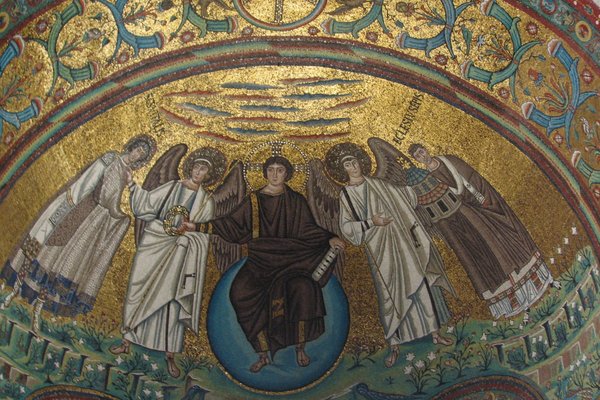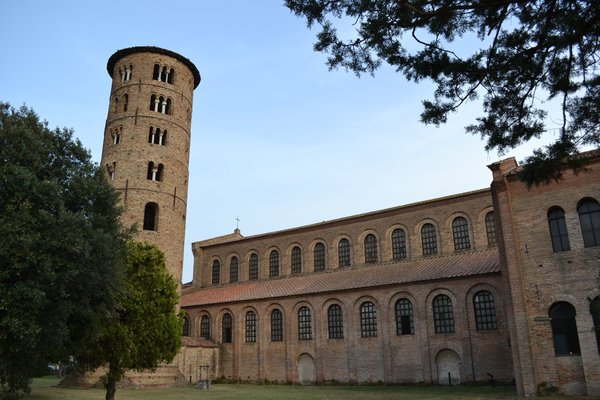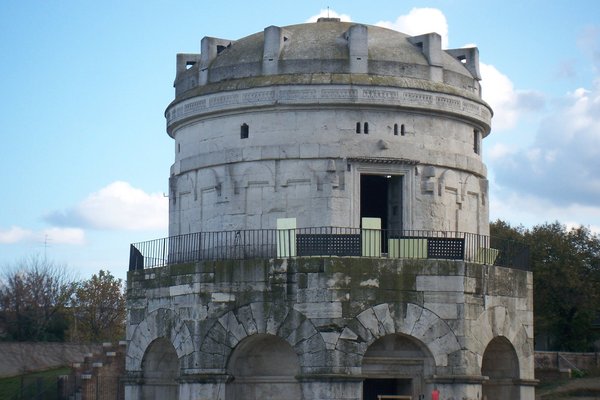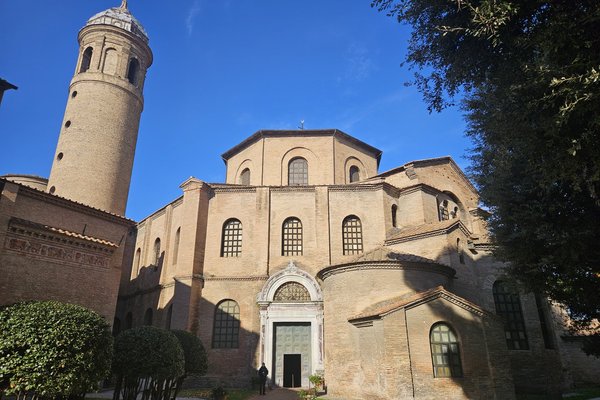Italy
Ravenna
The Early Christian Monuments of Ravenna comprise a unique collection of mosaic art and monuments from the 5th and 6th centuries.
Ravenna, the capital of the Late Roman Empire and Byzantine Italy, developed into a major centre of Christian art and culture at the instigation of Galla Placidia, the wife of Western Roman Emperor Constantius III. Its religious and funerary art and architecture blends oriental and western styles and mostly stands out for its mosaics.
Community Perspective: The monuments that contain the mosaics are spread out over several locations in and around Ravenna. “It is really impossible to say which monument and mosaic is the most impressive”, so try and see as many as you can.
Site Info
Official Information
- Full Name
- Early Christian Monuments of Ravenna (ID: 788)
- Country
- Italy
- Status
-
Inscribed 1996
Site history
History of Ravenna
- 1996: Revision
- Formerly on T-List as Ravenna e Pomposa
- 1996: Inscribed
- Inscribed
- Type
- Cultural
- Criteria
- i
- ii
- iii
- iv
Links
- UNESCO
- whc.unesco.org
- Official
-
- turismo.ravenna.it — Turismo Ravenna
All Links
UNESCO.org
- whc.unesco.org — whc.unesco.org/
Official Website
- turismo.ravenna.it — Turismo Ravenna
Community Information
- Community Category
- Religious structure: Christian
Travel Information
Emilia-Romagna and Marche Hotspot
Recent Connections
-
Prayer Labyrinth
The Basilica of San Vitale, contains a …
-
Perfect Inscriptions
1996 -
Belisarius
Basilica of San Vitale: "At the foot of…
Connections of Ravenna
- Individual People
-
-
Emperor Justininian
The Church of San Vitale, dating from 548, was built under the sponsorship of Justinian I and his wife Theodora who both are memorialized in mosaics on the North and South walls of the apse. How "personal" this sponsorship was is disputed and indeed a construction of this name had been commenced prior to Ravenna's capture from the Ostrogoths by Justinian's general Belisarius in 540 (after which Ravenna was made the seat of Byzantine government in Italy). The design does appear however to have been completely revamped and it has been suggested that it reflects that "of the Byzantine Imperial Palace Audience Chamber, of which nothing at all survives". -
Frederick II
Captured in 1240 -
Belisarius
Basilica of San Vitale: "At the foot of the apse side walls are two famous mosaic panels, completed in 547. On the right is a mosaic depicting the East Roman Emperor Justinian I, clad in Tyrian purple with a golden halo, standing next to court officials, generals Belisarius and Narses, Bishop Maximian, palatinae guards and deacons."See en.wikipedia.org
-
Gustav Klimt
Klimt's use of gold leaf in paintings was inspired by a trip he made to Italy in 1903. When he visited Ravenna he saw the Byzantine mosaics in the Church of San Vitale. For Klimt, the flatness of the mosaics and their lack of perspective and depth only enhanced their golden brilliance, and he started to make unprecedented use of gold and silver leaf in his own work.See en.wikipedia.org
-
Charlemagne
Charlemagne's Palatine Chapel both uses San Vitale in Ravenna as a partial model and inspiration and incorporates materials taken on Charlemagne's orders from Ravenna . "Charlemagne visited Ravenna three times, the first in 787. In that year he wrote to Pope Hadrian I and requested "mosaic, marbles, and other materials from floors and walls in Rome and Ravenna, for his palace" ... The Chapel of San Vitale makes use of ancient spolia conceivably from Ravenna (Einhard claimed they were from Rome and Ravenna), as well as newly carved materials." Wiki (Einhard was a servant to and wrote a biography of Charlemagne) -
Galla Placidia
Her mausoleum is here (though it does not contain her remains)
-
- Geography
- Trivia
-
-
In Video Games
Age of Empires II: Goths: Mausoleum of Theoderic I; Civilization VII: Mausoleum of Theodoric -
Depicted in Mizielinska Maps
San Vitale, Mosaic of sheepSee i.pinimg.com
-
Only portion of building inscribed
Only the Archiepiscopal Chapel, part of the former bishop's palace
-
- History
-
-
Byzantine Empire and Civilization
Byzantine capital in Italy through the fifth and sixth centuries....The Basilica of San Vitale, from the time of Justinian, is one of the highest creations of Byzantine architecture in Italy (OUV) -
Located in a Former Capital
Western Roman Empire (402-476) -
Pentapolis
a Pentapolis including: Ravenna, Forlì, Forlimpopoli, Classe, Caesarea -
Eunuchs
Basilica of San Vitale: "Another panel shows Empress Theodora solemn and formal, with a golden halo, crown and jewels, and a group of court women as well as eunuchs."See en.wikipedia.org
-
Fusion
"The Early Christian Monuments of Ravenna are without parallel because of the crucial evidence they provide of artistic and religious relationships and contacts at an important period of European cultural history. The mosaics are among the best surviving examples of this form of art in Europe and have an increased significance due to the blending of western and eastern motifs and techniques". (Official description – Criterion ii) Of the Sant'Apollinare Nuovo, the AB Ev mentioned that "both the exterior and the interior of the basilica graphically illustrate the fusion between the western and eastern styles characteristic of the late 5th-early 6th century." (AB Ev) -
Popes
Mausoleum of Theodoric: Pope Victor II "died at Arezzo (...). Victor's retinue wished to bring his remains to the cathedral at Eichstätt for burial. Before they reached the city, however, the remains were seized by some citizens of Ravenna and buried there in the Church of Santa Maria Rotonda [(this is the mausoleum)], the burial place of Theodoric the Great."See en.wikipedia.org
-
- Architecture
-
-
Octagons
Basilica of San Vitale, Arian Baptistery, Baptistery of Neon -
Tetraconch
The Mausoleum of Galla Placidia in Ravenna (425–30), world-famous for its mosaics, is almost a tetraconch, although there are short vaulted arms leading from the central space to each apse-end. These end in a flat wall with no semi-dome, and the entrance end is slightly longer (wiki) -
Baroque
The dome of the Church of San Vitale "is decorated with baroque frescoes executed in 1778-82, and in stark contrast to the architectonic purity of the structure." (AB Ev) -
Brick architecture
The mausoleum of Galla Placidia, the Neonian Baptistry, the Basilica of Sant'Apollinare Nuovo, the Arian Baptistry, Sant'Apollinare in Classe (AB Ev) -
Domes
The domes of the mausoleum of Galla Placidia, the Neonian Baptistry, the Arian Baptistry, the Basilica of San Vitale (AB Ev) -
Mosaic art
"The Early Christian Monuments of Ravenna are of outstanding significance by virtue of the supreme artistry of the mosaic art they contain." (Official description – Criterion i) -
Spolia
The Basilica of Sant'Apollinare in Classe: "It was certainly located next to a Christian cemetery, and quite possibly on top of a pre-existing pagan one, as some of the ancient tombstones were re-used in its construction."See en.wikipedia.org
-
- Damaged
-
-
Destroyed or damaged by Earthquake
The apse of the Basilica of Sant'Apollinare Nuovo was destroyed by an earthquake and reconstructed. This explains why it isn't covered in mosaics like the walls of the church.See fr.wikipedia.org
-
Damaged in World War I
"The Basilica of Sant' Apollinare Nuovo .....The present apse is a reconstruction after being damaged during WWI" (Wiki)
-
- World Heritage Process
-
-
Reduced from broader TWHS
From 'Ravenna and Pomposa' -
Perfect Inscriptions
1996
-
- Religion and Belief
-
-
Legends and Folk Myths
Mausoleum of Theodoric: "A large crack is evident on the southern side of the monolith. According to legend, this was caused by a bolt of lightning that hit the mausoleum while the king was inside. It is said that Theodoric actually had the mausoleum built with a monolithic roof so that he could take shelter during storms, because it had been predicted that a bolt of lightning would strike him to death." (Explanatory text outside the mausoleum) -
Religious Relics
"The relics of Saint Apollinaris were transferred from the Basilica of Sant'Apollinare in Classe" to the Basilica of Sant'Apollinare Nuovo "because of the threat posed by frequent raids of pirates from the Adriatic Sea."See en.wikipedia.org
-
Benedictines
The Church of San Vitale was, at one time, part of a Benedictine monastery. (AB Ev) -
The Magi
Basilica of Sant'Apollinare Nuovo: one of the mosaic rows shows "a procession of the 22 Virgins of the Byzantine period, led by the Three Magi, moving from the city of Classe towards the group of the Madonna and Child surrounded by four angels. (The Magi in this mosaic are named Balthasar, Melchior and Gaspar; this is thought to be the earliest example of these three names being assigned to the Magi in Christian art.)"See en.wikipedia.org
-
- Human Activity
-
-
Frescoes or murals by famous painters
Basilica of San Vitale: "The Baroque frescoes on the dome were made (...) by S. Barozzi, Ubaldo Gandolfi and Jacopo Guarana."See en.wikipedia.org
-
Grand Tour
Mausoleum of Theodoric: "In the Nineteenth-century, the Gothic king's mausoleum also became a favourite destination for travellers on the Grand Tour." (Explanatory text outside the mausoleum)
-
- Constructions
-
-
Prayer Labyrinth
San Vitale basilica -
Cemeteries
The Basilica of Sant'Apollinare in Classe "was built on an earlier (2nd-3rd century) cemetery, where Apollinare, the first bishop, was buried." (AB Ev) "It was certainly located next to a Christian cemetery, and quite possibly on top of a pre-existing pagan one, as some of the ancient tombstones were re-used in its construction."See en.wikipedia.org
-
Monumental Monoliths
Roof Dome of the Mausoleum of Theodoric. 300 tonne , 10 metres in diameter -
Prayer Labyrinth
The Basilica of San Vitale, contains a permanent floor labyrinth integrated into the 6th-century mosaic pavement. Located in the presbytery, this circular design features a single, winding path of marble tesserae leading toward a central point. While smaller in scale than the Gothic "walking" labyrinths, it functions as a meditative "prayer labyrinth." Its purpose was to facilitate spiritual growth by requiring the worshiper to trace the difficult path to the center visually or with a finger, symbolizing the soul’s journey through the complexities of the world toward salvation (link)
-
Mausolea
Mausoleum of Galla Placidia, Mausoleum of Theodoric -
Baths
Ancient Roman Bath turned into a baptismal font in the Neonian Baptistery
-
- Timeline
-
-
Built in the 5th century
Earliest monuments date from the 5th century, including the "Mausoleum of Galla Placidia, built in the second quarter of the 5th century"
-
- WHS Hotspots
-
-
Emilia-Romagna and Marche Hotspot
2h by train
-
- Literature & Film
-
-
Poetic Quotations
There is a reference to the Mausoleum of Galla Placidia is Ezra Pound's Canto XXI: "And there was grass on the floor of the temple, / Or where the floor of it might have been; / Gold fades in the gloom, / Under the blue-black roof, Placidia's, / Of the exarchate; and we sit here / By the arena, les gradins ..."
-
News
No news.
Recent Visitors
Visitors of Ravenna
- AC
- Adrian Turtschi
- Alberto Rodriguez Gutierrez
- Alexander Barabanov
- Alexander Lehmann
- Alex Goh
- Aljaz
- A. Mehmet Haksever
- Ammon Watkins
- Ana
- Ana Lozano
- Anna Wludarska
- Argo
- arnaugir
- Artur Anuszewski
- Aspasia
- Astraftis
- a.thum
- Atila Ege
- Badwater
- BaziFettehenne
- Bill Maurmann
- Bin
- Bodil Ankerly
- Brendan Carroll
- butterflybird
- Caspar
- CeeMon
- Cezar Grozavu
- chenboada
- chenqtao
- Cheryl
- Chole Ross
- Christer Sundberg
- Christoph
- Christravelblog
- Claire Bradshaw
- Cluckily
- Clyde
- Coppi
- Cristina Erba
- Csaba Nováczky
- CugelVance
- Cyberczar
- Damientournay
- Dani Cyr
- Daniela Hohmann
- Daniel Chazad
- Dan Pettigrew
- dave wood
- David Aaronson
- David Berlanda
- DavidS
- Dimitar Krastev
- Dimitrios Polychronopoulos
- DL
- Dorejd
- DouglasR
- Dr. Caligari
- Dwight Zehuan Xiao
- edstar500
- Elia Vettorato
- Elis
- Els Slots
- erdsaumnaht
- Eric Lurio
- Errol Neo
- Ertai
- Eva Kisgyorgy
- Evgenii
- Fan Yibo
- Farinelli
- fedemarch92
- Federico P.
- Feldhase
- Felicité
- Fernweh
- Filip Murlak
- Filippo Ubaldi
- flahr
- Flexiear
- Fmaiolo@yahoo.com
- Frédéric M
- Frederik Dawson
- FS
- Gary Arndt
- George Gdanski
- GeorgeIng61
- Gernot
- giulio25
- grimloch
- Hadrianus
- Hammeel
- Harald T.
- Harry Mitsidis
- Hasco
- henrik_hannfors
- Hubert
- Hurrvinek
- Iain Jackson
- Igloo
- Ilya Burlak
- Ingrid
- Ivan
- Ivan Rucek
- jacob76
- Jakob F.
- Jakubmarin
- Jana and Matt
- Janina Lehmann
- janis
- Jan-Willem
- Jarek Pokrzywnicki
- Javier
- Javier Coro
- Jezza
- João Aender
- JobStopar
- Joebobs
- Joel on the Road
- Jonas Hagung
- Jonas Kremer
- Jonoprout
- Joyce van Soest
- Jurre
- Just_hatched
- Justin
- KarenBMoore
- Karito Vies
- kathryn.park
- Ken DJ
- KentishTownRocks
- Kerékgyártó
- Kjsisney
- Klara Woodson
- Klaus Freisinger
- Knut
- KoenigMarke
- Krijn
- Krzysztof B
- Kurt Lauer
- kutasp
- La Concy
- Lara Adler
- LaVale
- Lazerway
- Lillybett
- lindaann
- Lisu Marian
- Loic Pedras
- Luboang
- Lucio
- Luis Filipe Gaspar
- Lukasz Palczewski
- Maciej Gil
- Mahuhe
- Malgorzata Kopczynska
- Manuelfunk
- marcel staron
- MarcoB_0
- marc Rouserez
- Martin
- Martinacurra88
- Martina Rúčková
- Matejicek
- MAURO PODDA PANI
- Max
- MaYumin
- MH
- MichaelH
- Michael Turtle
- Mikan22
- Mikko
- Milan Jirasek
- Miloš Tašković
- MMM
- Mo-han Je
- Mohboh
- Monica Tasciotti
- Morodhi
- Mozzer76
- Naim Y
- nan
- napalm
- Nasebaer
- Nick M
- Nihal Ege
- nikolamus
- Nolan B.
- opperpco3
- PabloNorte
- palka25
- Patrik
- Paul Schofield
- Peter Lööv
- Petteri
- Philipp Leu
- Philipp Peterer
- phillipmeng
- Pincze
- Piotr Wasil
- Porcho
- Purrfect
- Rafał Kałczuga
- Ralf Regele
- Ralf Rotheimer
- Randi Thomsen
- Reiseblitz
- Reiseblog
- Reisedachs
- Remigiusz
- Reza
- Riccardo Quaranta
- Rick Ohm
- RobRos
- Roccobot
- Roger Ourset
- Roman Bruehwiler
- Roman Raab
- Sabrina Liebehentschel
- Samato
- Samy G
- Sandmann15
- Sclowitz
- SDMArado
- Sebasfhb
- Sehnsuchtsbummler
- Sergio Arjona
- Shandos Cleaver
- Shijie ZHU
- shoaibmnagi
- Shombob
- sime147
- SirLoydd
- Slavi
- Solivagant
- Sorel Americo
- Stanislaw Warwas
- Stefan A. Michelfeit
- Stijn
- Sutul
- Svein Elias
- Szabolcs Mosonyi
- Szabo Viktoria
- Szucs Tamas
- Tamara Ratz
- Tammy Gouldstone
- Taotao Chen
- Tarquinio_Superbo
- Thomas Buechler
- Thomas van der Walt
- Thorben
- Tim Allen
- Tinamu
- Tom Flaten
- Tonisan
- tony0001
- triath
- Truls Brekke
- Tsunami
- usagi1974
- ValiaVeweth
- Vanessa Buechler
- VB73
- Viaje al Patrimonio
- V&M
- WalGra
- Walter
- Westwards
- WILLIAM RICH
- Wimmy
- Wojciech Fedoruk
- Xander Huang
- Xiquinho Silva
- YaroMir
- Yevhen Ivanovych
- Yongcheng Liu
- Zoë Sheng
- Zsuzsanna Forray
Community Reviews
Show full reviews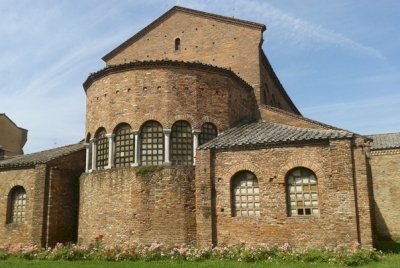
Mosaics of Ravenna are the world-class WHS, and everything important about inscribed monuments has been already covered by other reviewers. Thus, I decided to describe other important but un-inscribed sites in Ravenna. I believe that it is helpful to understand the importance of Ravenna in context. Not to be misunderstood, the list of the inscribed sites is complete in my opinion, and important but un-inscribed monuments were heavily altered in midle ages and modern times, thus they have lost some of their qualities (mostly mosaics...)
It happened to me during my visit in May 2018: We walked with my friends from the parking lot (for free on Sunday) close to railway station towards Piazza del Popolo. We passed by an antient church, and my friend told: Nice church, let`s go inside! As a WHS enthusiast, I refused this idea, because that church is NOT inscribed and probably contains NO mosaics inside running towards S Vitale... Now, after spending a couple of days in Ravenna, I am better informed and know that that church was S Giovanni Evangelista founded by Galla Placidia... PHOTO
(i) S Giovanni Evangelista is one of the oldes churches in Ravenna founded by Galla Placidia close to the port. It partly retains classical shape of Ravenna`s basilica: 3 naves with classical columns, apsida and atrium. Nowadays shape is the result of after-war reconstructions due to the bombing because of a fatal location close to the railway station. The original apsida was round inside and polygonal …
Keep reading 0 comments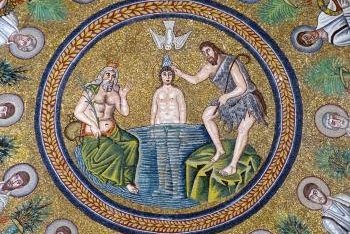
If you arrive in Ravenna by car you will face the usual problem of where to park during your visit. Now, I am congenitally incapable of willingly paying for parking - indeed we toured Italian WHS for 17 days and only spent 2.60 euros on it! Even if others are not so “penny pinching” it may be of use to know that there is a large, well paved area of free, long term parking in front of the Mausoleum of Theodoric. You are going to want to visit there anyway and the car park is only a 15 minute walk from the San Vitale complex and the city centre.
Another logistical aspect about Ravenna’s WHS which it is worth understanding is the ticketing system – this is complex even by Italian standards. There are 8 inscribed locations – 5 of these (Archiepiscopal Museum with the Chapel of Sant’Andrea and the Ivory Throne, Neonian Baptistery, Basilica of Sant’Apollinare Nuovo, Basilica of San Vitale and the Mausoleum of Galla Placidia) are in Ravenna centre and require a combined entry ticket (you cannot buy an individual ticket for any of them), 1 (Arian Baptistry) is also in the centre and is free to enter and 2 (Mausoleum of Theodoric on the city outskirts and Basilica of Sant’Apollinare 6kms away in Classe) require a different combined entry ticket. That combined ticket also includes the (non-UNESCO) National Museum at San Vitale and these 3 sites are also available for entry by individual tickets at each …
Keep reading 0 comments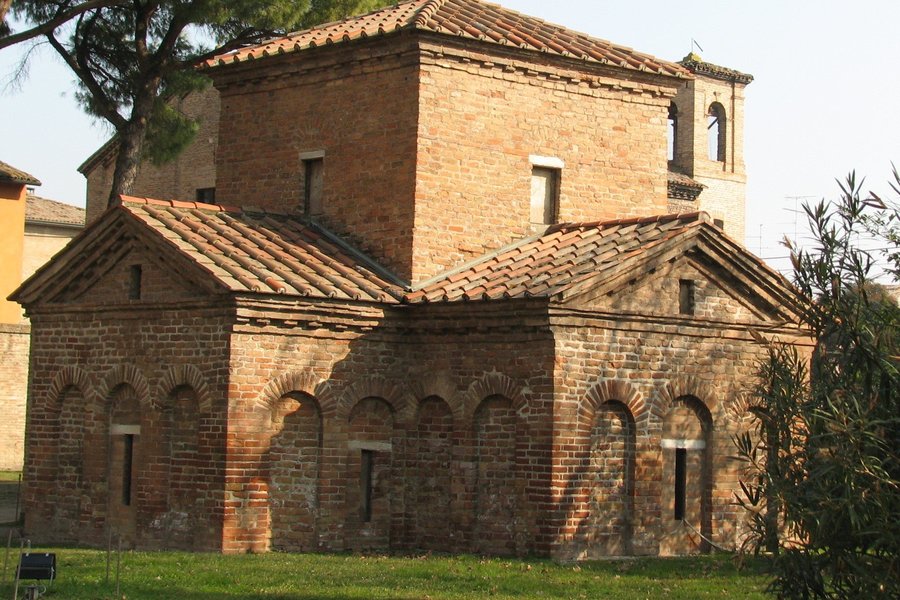
In my opinion, Ravenna is one of the finest and most interesting WH sites not just in Italy, but in all of Europe. The remains from the late Roman/early Byzantine Empire and the early Christian era are incredibly well-preserved and the mosaics for which Ravenna is so famous are just stunning in every way. The WH listing consists of 8 distinct sites that can be easily visited on a walk through the city (except for Classe). From the station, I first went to the Arian Baptistry (a small building with a nice ceiling mosaic), then to the Basilica of Sant' Apollinare Nuovo (a large complex with 2 fantastic rows of mosaics plus some hard-to-spot hands showing Theoderic and his court that were not quite removed when the Byzantines reconquered Ravenna). After a detour to Dante's Tomb and the Basilica of San Francesco with its famous groundwater-covered mosaic floor, I went to the Neonian or Orthodox Baptistry (larger and much more decorated than the Arian one, with exceptionally beautiful mosaics) and then to the Cathedral Museum, which houses the Archiepiscopal Chapel and the only remaining oratory from the early Christian era. Then I continued to the San Vitale complex, which includes the Basilica boasting Ravenna's most famous mosaics which show Emperor Justinian and his (in)famous wife Theodora, who, despite never having set foot in the city, still wanted to project their power in their remaining Italian lands. The complex also features the Mausoleum of Galla Placidia, which contains the city's oldest …
Keep reading 0 comments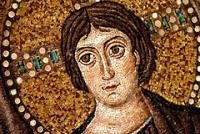
I visited this WHS in September 2012. It is truly a hidden gem! The terracotta monuments are a treasure chest of mosaics, one more beautiful than the other. I visited all 8 listed sites and my favourite is the Cappella S. Andrea (Arcivescovile), a small private chapel with fine mosaics (the highlight is the gold/blue sky with 99 species of birds). The least aweinspiring of the sites was perhaps the Mausoleo of Teodorico which is quite a walk out of the historical city centre. The Basilica in Classe is also worth visiting. I reckon Ravenna is one of my favourite WHS in Italy.
Keep reading 0 comments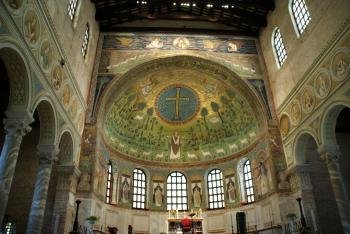
The Ravenna WHS consists of eight early Christian monuments of the 5th and 6th Century: basilicas, baptisteries and mausoleums. Probably the significance of the monuments alone would justify the inscription, because little is preserved from the period between the Roman Empire and the Christian Middle Ages. But the exceptional feature of the site are the marvellous mosaics.
We started our tour, like probably the most visitors, at the Basilica of San Vitale. San Vitale is an octagonal building and has mosaic decorations on the walls and the ceiling. The exceptionally well preserved mosaics depict scenes from the Old Testament and portraits of the Emperor Justinian and his wife Theodora accompanied by their entourage. The mosaics glow in gorgeous colours: blue, green and gold. It is hardly possible to describe how impressive they are and photos can not adequately illustrate their magnificence. You have to see them.
Close to the Basilica San Vitale is the Mausoleum of Galla Placidia. Mosaics cover the entire surface of the vault, the central dome and large parts of the walls. The ceiling shows a deep blue sky with white and golden stars. The theme is the Redemption, Jesus is shown as the Good Shepherd with his sheep, and the apostles are depicted.
Next we went to the Neonian Baptistery near the Cathedral. It is dominated by the large octagonal baptismal font made of marble. The mosaic at the ceiling depicts the baptism of Jesus in the Jordan by John the Baptist. Also the walls are …
Keep reading 0 comments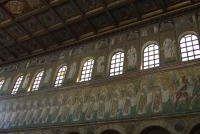
This is truely a city of stunning mosaics, and all but one of the 8 sites listed in this WHS is decorated with the most colourful of mosaic art. By contrast the Mausoleum of Theodoric has a few faded frescoes and a red stone hip bath. Why was this included in the WHS?
The two churches of St Appolina, one in Ravenna, the other in Classe were for me the most outstanding. I travelled between the two by bus #4 and by train.
In 2011, to visit all 8 sites cost E19.50.
Keep reading 0 comments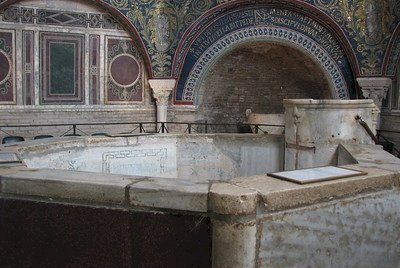
Ravenna is a fairly large city, and the monuments that contain the mosaics are spread out over several locations. One is even in another town, in Classe. I had some trouble orientating myself at first, though there are signposts to the churches. And I had to take care where I was walking, because Ravenna appeared to be a town of cyclists, passing the pedestrians on all sides.
First I arrived at the Basilica of San Vitale. Here I paid the entrance fee of 8.5 EUR which is valid for 5 of the major monuments. What to say about the Basilica? It is an octagonal building, somewhere between Roman and Byzantine in style. Its interior has to be seen to be believed: there are mosaics everywhere, on the floor, on the walls, on the ceiling. Lots of gold, and clear Christian symbols.
At the back of the Basilica lies the Mausoleum of Galla Placidia. This is a tiny building. Access is limited to 5 minutes, so I had to wait with a couple of others for our time slot. Certainly worth waiting for - the mosaics here seem a little older and less refined. But what a brilliant blue mosaic that covers the hallway!
Another cluster of these monuments is located about 15 minutes away by foot. Next to the giant Duomo lies the Neonian Baptistery. As small as the Mausoleum, but worthy in its own right. The floor and baptismal font (a former Roman bath) are made …
Keep reading 0 comments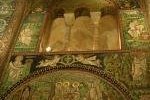
Wow! There's no other word to describe the reaction when you enter the Basilica di San Vitale for the first time. The shimmering gold and the brilliant greens of the mosaics are just jaw-droppingly beautiful. Do you remember all those pictures from your art history or European history text books? Here they are. Justinian, Theodora, and the last vestiges of the glories of the Western empire are on display here. Due to Ravenna's having served as the capital of the empire for a short period after the sacking of Rome, there exist numerous other impressive monuments from the 5th and 6th centuries AD, such as Mausoleo di Galla Placidia, Sant'Apollinaire Nuovo, and the Neonian Baptistery. All are easily visited in an afternoon, and all are covered by a joint ticket costing 9.50 euros (as of May 2005).
Keep reading 0 comments
